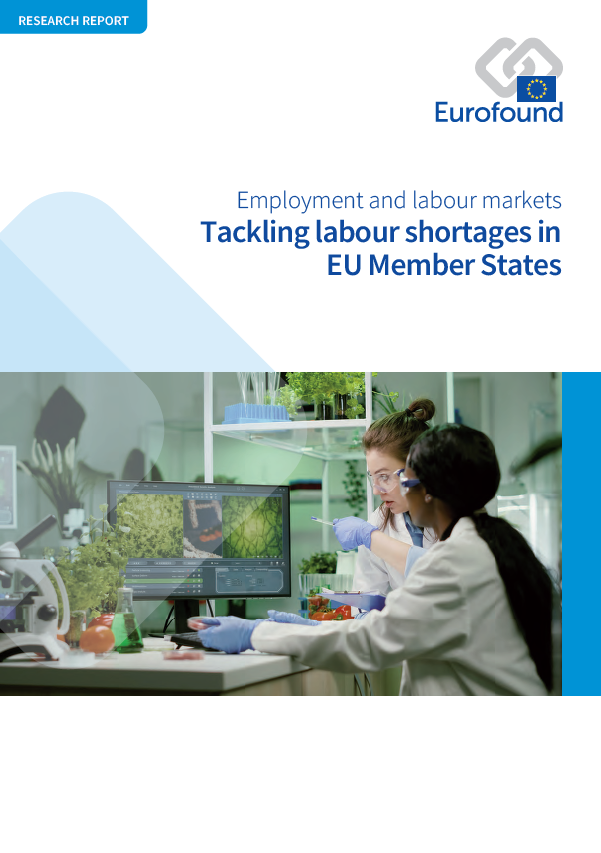
Abstract
While unemployment is still a huge challenge in Europe, some countries, sectors and occupations are experiencing labour shortages. This report explores various approaches to identifying labour shortages and maps national policy debates around the issue. It documents public and social partner interventions to tackle labour shortages, such as measures fostering geographical or occupational mobility, addressing skills shortages and underinvestment in skills, improving working and employment conditions, and providing better matching procedures.
Key findings
- Between 2013 and 2019, labour shortages increased in the EU. While the unmet demand for labour – measured in terms of vacancy rates – dipped from 2.3% in the third quarter of 2019 to 1.7% in the same quarter of 2020, the COVID-19 pandemic accentuated long-standing shortages in sectors such as healthcare and ICT.
- Labour shortages vary across country groups. The largest shortages are reported in the manufacturing and construction and services sectors in eastern Europe, where in 2019, 39% of companies in manufacturing and 42% of companies in construction point to labour shortages as a factor limiting production.
- In the context of the post-COVID-19 recovery, the construction, energy, manufacturing and transport sectors are likely to be impacted by the transition to a climate-neutral economy, requiring additional labour and new skills.
- Three main types of measures can be used to address labour shortages: measures to enhance the attractiveness of specific regions, sectors or occupations; measures to overcome labour market barriers faced by groups such as persons with disabilities, women, migrants or ethnic minorities; and measures to enhance the use of existing labour by improving job matching services, addressing skills mismatches and preventing exit from the labour market. In designing policies to address labour shortages, a clear assessment of the main drivers of shortage at national, regional and sectoral level is critical, while in order to achieve sustainable outcomes, policy measures should tackle the underlying causes of shortages.
- Social partners have a key role to play in the design and implementation of measures to tackle labour shortages, as they are at the heart of emerging trends and labour demands. Individual employers can play a critical role, not least because their influence on the creation of profiles of the workforce and skills required, the working conditions and levels of pay offered can have a direct bearing on the extent to which recruitment difficulties emerge.
The report contains the following tables and figures.
List of tables
- Table 1: Typology of measures to address different drivers of labour shortages
- Table 2: Drivers of labour shortage
- Table 3: Descriptions and advantages and disadvantages of indicators and sources of labour shortages at EU level
- Table 4: Indicators used in EU Member States to assess labour shortages
- Table 5: Sectors with large (greater than 2%) vacancy rates in EU Member States with more than two subsectors affected by large vacancy rates, Q3 2020 (%)
- Table 6: Most prevalent shortage occupations, 2020
- Table 7: Shortage sectors linked to the transition to a climate-neutral economy
- Table 8: Clusters of key areas of policy debate in the EU Member States, 2020
- Table 9: Key focus of policy debate on labour shortages in EU Member States before the onset of the COVID-19 pandemic
- Table 10: Typology of measures to address different drivers of labour shortages
- Table 11: Relative importance of different types of measures implemented to address labour shortages, EU27, spring 2020
- Table 12: Overview of measures adopted to address shortages in key shortage sectors, occupations and regions, EU27, spring 2020
- Table 13: Specific managed migration initiatives that aim to address labour shortages in key shortage sectors/occupations, EU27, spring 2020
- Table 14: Measures taken at Member State level to activate underutilised resources and retain labour, EU27, spring 2020
- Table 15: Measures taken at Member State level to enhance the use of existing labour to assist in addressing shortages, EU27, spring 2020
- Table 16: Skills anticipation methods, data requirements, and advantages and disadvantages
- Table 17: Active labour market policies focusing on training for shortage occupations, EU27, spring 2020
List of figures
- Figure 1: Proportion of the inactive population aged 15–74 years representing the potential additional labour force by subgroup and country, seasonally adjusted data, EU27, Q3 2020 (%)
- Figure 2: All part-time workers and underemployed part-time workers as a proportion of total employment, EU27, 2019 (%)
- Figure 3: Job vacancy rate, EU27, Q3 2013, Q3 2019 and Q3 2020 (%)
- Figure 4: Unemployment versus job vacancy rate – Beveridge curve, EU27, Q3 2013–Q3 2020
- Figure 5: Average job vacancy rate versus average unemployment rate by Member State – Beveridge points, EU27, Q3 2020
- Figure 6: Proportion of establishments with 10 or more employees having difficulties in recruiting employees with the required skills, EU27, 2019 (%)
- Figure 7: Trends in vacancy rates in the manufacturing, construction and services sectors, EU27, Q3 2013, Q3 2019 and Q3 2020 (%)
- Figure 8: Proportion of companies in the manufacturing, construction and services sectors citing labour shortages as a factor limiting production, EU27, Q3 2013–Q3 2020 (%)
- Figure 9: Proportion of companies citing labour shortages as a factor limiting production across European regions, by broad sector, Q3 2013–Q3 2020 (%)
- Figure 10: Main shortage occupations – number of countries reporting shortages in different occupations, EU27, 2020
- Figure 11: Coefficient of variation in NUTS 2-level employment rates for the 15–64 age group in 2019 and change in the coefficient between 2013 and 2019, EU27 (%)
- Figure 12: Top labour shortage regions (in blue), EU27, 2020
- Figure 13: Intensity of policy debate relating to labour shortages, EU27, 2020
- Number of pages
-
82
- Reference nº
-
EF21006EN
- ISBN
-
978-92-897-2181-3
- Catalogue nº
-
TJ-02-21-742-EN-N
- DOI
-
10.2806/363602
- Permalink
Cite this publication
Eurofound (2021), Tackling labour shortages in EU Member States, Publications Office of the European Union, Luxembourg.